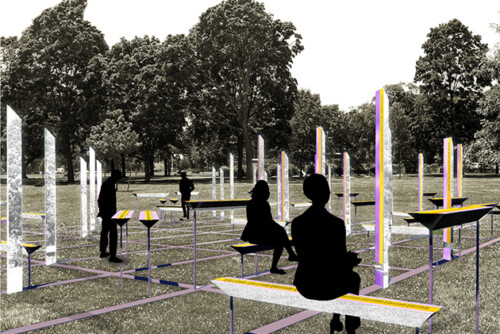Our goal for this issue, then, is to produce an understanding of the ways a multiplicity of voices can co-exist, albeit messily, and point toward new methods of rethinking and envisioning the complexities of feminisms and movements for social change. We want to articulate the ways the concreteness of people’s lives and the abstractions of theory can work together. Joining together words and images, text and visual art, can aid in continuing the calls for reconnections of those things that have been forcibly separated and theorizing strange juxtapositions of “unlike” elements: of the personal and the political, thought and affect, reason and emotion, body and soul, activism and academia.
Several pieces, for example, highlight the significance of bodily practices to connect “the personal” and “the political.” In her exploration of the significance of singing, Nomy Lamm connects working through the blocks one often experiences about singing with the awareness one can have of the energy and space one can take up in a room; this desire for intervention in what is often cited as one of the most difficult parts of alliance-building provides a clear example of how rejoining the body and mind can aid in social justice work. Similarly, Marta Sanchez’s analysis of dancing as a tool of community support for survivors of violence points to the importance of physical movement as a way to alleviate the suffering of trauma, and Lesleigh Owen explains how reconceptualizing a bar as a place for fat women to embody sexiness can become a space of reclamation and empowerment. These explorations into the implications of bodily practice open up possibilities for envisioning the materiality of strategies for social change.
Many of the contributors to this issue address what we might call “the vision question”—how we envision possibilities for alternative ways of living while remaining open to conflict, dissent, and rapidly changing social contexts. In other words, how can we take seriously wariness about the ways programmatic ideas of social change can and do generate repressive agendas without allowing those fears to stop us from imagining possibilities and alternative ways of being? Jessica Hoffmann describes a skill-sharing retreat where the lessons of visionary organizing become clear to her (and us), noting that the retreat left her “feeling inspired and more sure than ever that we do have the skills, wisdom, and resources we need to create systems—communities, ways of living—that are just and sustainable, if only we weren’t under the pervasive pressure of a system that keeps most of us too tired and busy and twisted up—too stolen from, too colonized, to do it.”
In order to record these existing practices, then, we draw on lived experiences of thinking and organizing to investigate methods that thinkers/activists/artists use to challenge established frameworks for organizing and intellectual work. Adrienne Maree Brown describes how The Ruckus Society moved from a white, male-led, hierarchical organization to a non-hierarchical activist space occupied primarily by women of color and members of the organization. Organizers of S.O.N.G. (Southerners on New Ground) discuss the importance of privileging a local vision of alternative possibilities and offering a place to address the everyday trauma of violence in ways that “build our collective liberation from our longing, desire, dreaming, creation as ways that allow healing and alternative responses to persecution, violence, and to the targeting and isolation of our communities.” And, as Shea Howell notes in “Does a Movement Need a Name,” a multigenerational video conversation directed by Adele Nieves, “Everyplace people were doing things that look like what we want a future to be.” This notion that the ideals we are thinking about are already happening is crucial to our idea that we need to highlight these practices to counter the pessimism seen in so much academic and activist thinking.
By collecting these pieces, we want to contribute to the (muffled) polyphonic conversation that already exists about the necessity of rethinking and reconsidering our individual, organizational, and intellectual models to document already-existing possibilities and continue the project of opening up spaces, visions, and ideas that create social change. In order to do this, we draw attention to various sticking points, to pay attention to their recurrence in ways that notes their significance while not allowing them to prevent us from doing our work. In other words, we envision this special issue as a kind of “taking stock” of where we are in feminist thinking, organizing, and creative practice; we hope to bridge divides—such as those between activism and academia, blogs and academic journals, non-profit organizations and artistic communities—while simultaneously maintaining the autonomy and significance of individual voices, dissent, and conflict. We dream of social movements that can address the trauma of everyday, systemic violence without silencing disagreements in the name of addressing that very same violence, movements that encourage and value the multiplicities of intellectual and creative approaches to social problems without prioritizing any particular way of speaking, understanding, and visualizing the world.



